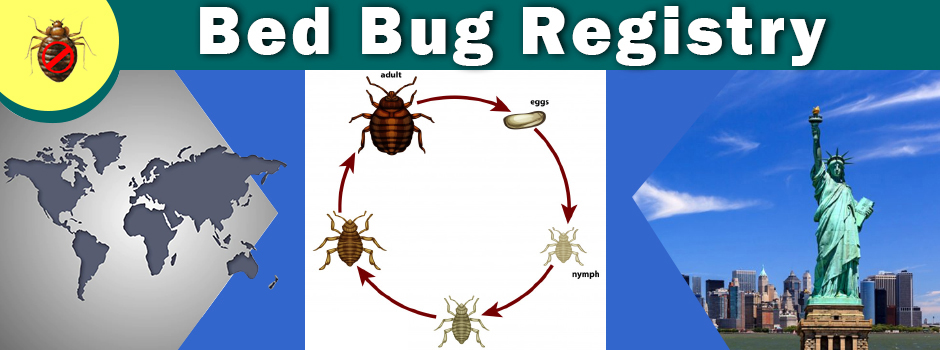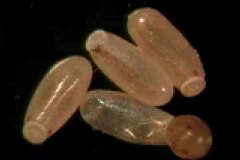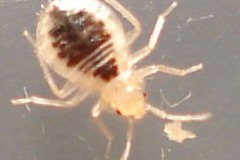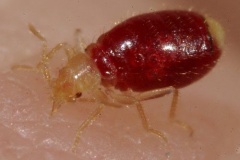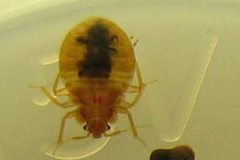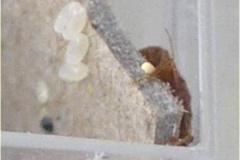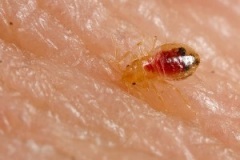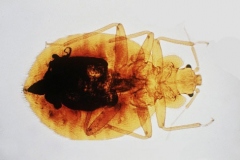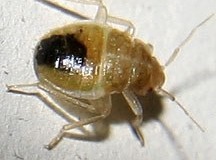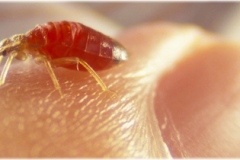From the Beginning
It is thought that C. lecturlarius may have actually originated in the Middle East, in caves that were inhabited by humans as well as bats. The lineages of the bed bug can be traced by their name as well. In ancient Rome, they were called Cimex, meaning bug, the species designation lecturlarius refers to a couch or bed.
They are ancient insects and they have lived off hosts since time began. Studies have suggested that they parasitized bats first and then moved on to humans. The bugs inhabited the same caves where civilization began.
These bugs have been found fossilized, dating back further than 3,500 years, and have been found at archaeological sites. During that age, the bugs were used as a potion to try to cure common ailments. They were burned by the Romans and Greeks to make leeches release their hold. To cure snakebite, Egyptians would drink them.
They thrived due to the formation of villages and then cities. Civilization grew and the bugs multiplied and spread all throughout Asia and Europe.
By 100 A.D., they were a well-known presence in Italy, in 600 A.D. in China, in the 1200s in Germany and the 1400s in France. Heat that was generated from cooking and sleeping fires afforded the bugs a comfortable life in the wealthiest families residing in castles and the less fortunate working class living in huts.
England first reported the bugs in 1583. Shortly thereafter, they arrived in the Americas, stowing away with the European explorers and the settlers.
In 400 BC, Ancient Greece mentioned the bugs and they were mentioned again by Aristotle. According to Plinys Natural History that was first published in Rome around 77 AD, medicinal values for these bloodsucking insects included the treatment of ailments like ear infections and snake bites.
This belief in their medicinal properties continued at least until the 18th century. That is when Guettard recommended using them to treat hysteria.
The early colonists brought the bugs with them to the Americas in the 1700s. In the earlier part of the 18th century, colonial writings document severe problems with them in Canada and the English colonies. In the 1800s, they were abundant in North America following the arrival of the European settlers.
In an attempt to deter the bugs, their beds were generally made out of sassafras wood and doused the crevices with boiling water, sulfur and arsenic. However, there was not a problem with them in the Indian villages.
It was known that old sailing ships were overrun with these offending bugs. Many sailors had complained that bugs were attacking them while they were sleeping at night. They forbade colonists and passengers from bringing any bedding on board the ship.
Germany first mentioned the bugs in the 11th century. They were first mentioned in France during the 13th century. Englands first mention was in the year 1583, until 1670 the bugs were rather rare in England.
Some people in the 18th century thought that the bugs were brought to London in supplies purchased to rebuild London following the Great Fire in the year 1666.
In the 18th century, Giovanni Antonio Scopoli made note of their presence in Carniola, which is generally equivalent to Slovenia in present-day.
Railroads, hotels and ships were ideal accommodations. Travelers that were wise to their habits would pull their beds away from the walls and then immerse the legs in pans full of oil.
Over the years, there have been multitudes of formulas claiming they could assist in controlling infestations. If these formulas were used today, it could result in being incarcerated.
By the middle of the 1800s, the poor were plagued as well as the rich. These were overcrowded areas that had low cleanliness standards. The wealthier households that had excess domestic help discovered that vigorous housekeeping assisted in eliminating the pests.
The larger benefit from these kinds of efforts was detecting the infestations during their vulnerable initial stages. The greatest remedy is extreme cleaning and continuous care and examining all the joints and crevices to ensure there are no more residing in those dark crevices.
In the early 20th century, the majority of Americans had seen a one and most had been bitten. At that time, they were considered one of the top three pests concerning structures.
Surveys taken at that time showed that almost 1/3rd of all the residences in some of the cities were infested. In the lower income areas, nearly all the residences had been infested at some point. In the lower income areas, they were considered to be the #1 public enemy.
Then something surprising happened. All of a sudden, they were gone, at least in the countries that were developed. By the 50s, the American entomologists were having difficulty finding live bugs for their laboratory work. The question was what happened?
In the 50s, DDT was introduced to exterminate cockroaches and other bug populations and populations began to decrease rapidly. They met their match in DDT. The DDT would be dusted or sprayed all around and all over the bed.
This control would last at least a year. In 1972, DDT being used as a pesticide was banned. It was thought that DDT as well as other pesticides could cause cancer and also endangered wildlife, especially the bird population.
It is also believed that the vacuum cleaner and simplified furniture design also assisted in helping elimination. Some believe that it may have been the organisms cyclical nature.
These parasites reside all over the world. The infestation rates in the developed countries had decreased from the 30s to the 80s. However, their numbers have been greatly increasing since the 80s. Before this, they were still rather common in the developing parts of the world, but extremely rare in the developed world.
Infestations began increasing even more rapidly over the past few years. The current number of infestations is similar to the mid-century numbers that were seen. The number of infestations is still on the rise.
Despite the fact that they became resistant to DDT within several years, we were still able to control them with the use of other chlorinated hydrocarbons like lindane. An organophosphate insecticide known as malathion was also used.
By the mid 50s they were not a major pest in the household, now only an occasional pest. Generally, they would be found in the settings that were socially depressed or in areas with other rather unusual circumstances. Every so often a problem may arise in a prison, shelter, cabin or youth hostel, nearly never in hotels or homes.
These pests are the most detested of the household pests. Infestations are out of control and they can be difficult to eliminate. Previously, extermination treatments were sometimes dangerous to an individuals health. In the battle of todays worldwide resurgence, we can learn from the past.
They are famous for hiding in bags or attaching themselves to clothing to travel. Looking back in history we can see that the recent resurgence actually followed a comparable pattern.
The extreme infestations began once again in the late 90s. They first appeared in gateway cities like Miami, New York, San Francisco and Los Angeles.
In the middle to late 90s, they started to appear in more and more motels and hotels. These infestations were not limited to the less expensive establishments. They began showing up in premium hotels, single-family homes, apartments, hospitals and in nursing homes.
Unfortunately, today these bugs are still making a comeback. This is not a slow comeback, but a very fast-paced one. They are national news and there are media exposs uncovering attacks in some of the five star hotels.
Some of the research indicates that as many as 25% of the residents in various cities have reported bug problems. These infestations were generally being seen in the lower-class urban areas.
For the residents in these cities they are not just a nuisance, the infestations are reaching epidemic levels. Throughout history, this kind of intense and widespread infestation has NEVER been seen.
It is extremely clear that the bugs have made a major resurgence. This resurgence has occurred throughout most of the world. Their increase has been acknowledged for Canada, the United States, Australia and in parts of Europe and Africa.
Because of the recent increase in infestations all across America, an industry for the prevention, reporting of infestations and eradication has spawned.
The exterminators today are modeled after the very first European exterminators. One of the most famous of these was Tiffin & Son of London. They formed a business in 1690 to exterminate the bugs for the wealthier public. Their gas-lit sign over the shop read: May The Destroyers of Peace Be Destroyed by Us. Bug-Destroyers to Her Majesty. This recognized the continuous threat of possible infestation.
They worked by contract and examined the house each year. It was a precaution to keep the places comfortable because servants could bring them in their clothes and boxes.
Tiffin did report that the majority of bugs were found in beds, but did caution the public stating that if the bugs were not exterminated they would populate and climb all over the ceiling, colonizing wherever they are able.
Centurys after Tiffin & Son of London the pest management industry once again advocated preventive routine inspections. By catching an infestation early, it will reduce the spread into other places and can lessen some clients liability.
Another destroyer was John Southall who destroyed these bugs in England and published a 44-page manual in 1730. The treatise contained information concerning their control and prevention and on their habits that was based on his personal experiences.
To simplify treatment and limit harborage he suggested that beds needed to be plain and with as little woodwork as possible.
Pest control professionals and Entomologists have several reasonable theories pertaining to why the problems with these bugs have increased. Here are some of the possible reasons; however, no one is certain.
People travel to all the continents for business and pleasure. The developed countries are becoming more and more multicultural and the residents continue to move back and forth between countries. Naturally, this kind of travel would assist in their transportation.
Some of these areas being traveled have infestations. The bugs are removed from one area and then introduced to another in various ways. These bugs can be transported from one country to another on the body, clothing or even luggage. Many times they are found in airplanes, including in the cargo hold area. Overnight stays in motels; hotels and Inns can also assist in the transportation from one location to another.
Previously hotel rooms were usually treated regularly with residual pesticides. Because of this, these bugs that were introduced during travel would generally be exposed to that pesticide once they left their transport source to travel to the bed.
These kinds of residual pesticide application monthly or even quarterly treatments for other pests would control any new infestations. Currently, insecticide baits are commonly used as a substitute for the traditional sprays.
However, the baits are specifically designed for a certain type of pest like ants or cockroaches. There is not any bait used for the blood feeding insects.
During the mid 90s, a dramatic shift took place in the practices of pest management. Treatments that were routinely scheduled for the baseboards in motels, hotels and apartments were replaced. The replacement was a targeted application of baits for other pests such as cockroaches and ants.
Because of the residual pesticide application absence, the bugs traveled safely and freely from the individuals luggage, then to the bed and the infestation had now begun. It is extremely probable that factors like these have played a major role in their re-establishment in the United States.
The lack of community awareness is assisting in their transfer from one location to another.
People need to be more diligent and inspect their items regularly during travel. They should also take the time to inspect any of the places they reside in while away from home for evidence of bug infestation.
People also need to inspect any second-hand items they are considering to purchase or if nothing else, prior to bringing them into their home.
There are enormous populations of temporary workers or illegal aliens in many cities. These workers and illegal aliens are continuously moving in and out of residences. Most of these residences house groups of people and are located in low-income apartments.
For instance, in Washington DC, it is not considered to be unusual to find more than a dozen people residing in an apartment with only three bedrooms.
The mix of people in these apartments is continuously changing as people move back to their home country; change jobs or decide to move to another city. These kinds of residences can easily become heavily infested.
The truth is that if you are an illegal alien, you probably will not be contacting property management to complain about a problem with an infestation. Doing so could make your apartment the focus for any other infestations within the building.
Decreased focus on the control due to a greater focus on controlling other pests. These bugs have the ability to become immune to our pesticides.
Shabby-chic is all the rage right now. Thrift stores, flea markets, antique stores and garage sales are now more popular than ever.
Unfortunately, all these secondhand merchandise stores and markets increase your risk of becoming infested. In addition, many people do not think twice about picking up the recliner sitting on the side of the road. This practice also increases your chance of becoming infested.
The bugs are brought in on items that are infested, like clothing or furniture. Eggs and bugs enter the homes that have hitched a ride on pets or luggage. They are carried by wild animals like birds or bats entering the home.
Dwellings that are nearby that have routes available through false ceilings or ductwork. Visitors from an infestation source; these bugs are like roaches and are transferred from place to place on luggage, clothing or an individuals body.
These bugs are prolific breeders. Despite the fact that females have a reproductive tract, the male does not utilize this tract when mating. Instead, the male pierces the abdomen of the female with hypodermic genitalia and then ejaculates into the females body cavity.
The nymphs and males secrete hormones. These hormones label these bugs as sexually unsuitable. This is necessary to prevent injury. The fertilized female avoids the clusters of the other bugs to avoid any further injury. Usually, the fertilized female will leave in an attempt to find a place that is safer to lay her eggs.
Despite the hormones secreted by the nymphs and males, a male will sometimes try to mate with another male and pierce his abdomen. This kind of behavior happens because the sexual attraction is primarily based on size, not the hormone. This means that a male will mount any bug that has recently fed regardless of that bugs sex.
There is a pheromone emitted that is considered to be an alarm. This pheromone is released whenever a bug gets disturbed, such as during a predator attack. In a study done in 2009, males demonstrated the use of their alarm pheromone to repel any other male that is attempting to accidentally mate with them.
If given the opportunity, C. hemipterus and C. lectularius will mate with one another. However, the eggs that are produced are generally sterile. In a study done in 1988, 1 out of 479 fertile eggs resulted in a hybrid, known as C. hemipterus x lectularius.
These bloodsucking insects possess mouthparts that are adapted to pierce and then suck blood. The bottom lip, known as the labium, is modified and forms a grooved sheath that receives two sets of bristle like stylets. These stylets are the modified maxillae & mandibles.
Some people think that they are (Cimex electuaries) too small and cannot be seen with the naked eye very easily. This is untrue because the adult bug is about the size of an apple seed. However, after it feeds, it could grow up to three times its usual size. It also turns a reddish brown color following a feeding.
These insects are flat, oval shaped insects whose colors range from straw-colored to a mahogany brown. For this reason, some call the adults Mahogany Flats. The nymphs are almost translucent.
The upper body is crinkly resembling paper and covered by short, golden hairs. They are essentially wingless; the fore wings are symbolized by tiny vestigial scales. Their hind wings are absent. Their antennae can easily be seen.
Their first couple of segments looks angled. The microscopic hairs on their abdomens make them look banded or striped. They have compound eyes. These eyes are easily visible. Their eyes consist of 30 facets and look like cones.
Males are easily distinguished from the females because the end of their abdomen terminates into a sharp flap like segment. The end of the females abdomen is rounded.
Their legs are very well developed. This allows them to crawl easily on vertical surfaces of plaster, wood and paper. They can climb up dirty glass, but with difficulty.
They are sometimes mistaken for other insects including carpet beetles and booklice, or vice-versa. Unfortunately, the current registered pesticide poisons do not affect this species.
There are 92 recognized species and the relatives in the world.
These bugs belong to the hemiptera order that includes a variety of different forms including scorpions and aphids.
The majority of the hemiptera order actually feed on the sap of plants. Actually, many of these species are carriers of very important plant diseases.
There are a few species in the family known as Cimicidae and families that are related that feed on the blood of mammalian and birds.
Cimex lectularius is the common type. This species has adapted very well to human environments and lives in various climates around the world.
Cimex hemipterus is another species and is found in tropical regions of the world. In the United States, it is primarily found in Florida. This bug infests and feeds on poultry, bats and people.
The Leptocimex boueti is found in tropical regions of South America and West Africa. This species infests and feed on humans and bats.
The Cimex pipistrella, Cimex adjunctas and Cimex pilosellus are known as the bat bugs. These bugs for the most part infest and feed on bats.
The Haematosiphon inodora bug is found in North America. It chiefly infests poultry.
Oeciaus vicaruis is the swallow bug and Cimexopsis nycatalis, the swift bug
These bugs are bloodsucking (hematophagous) insects. Most of the species only feed on humans when there is no other prey is available.
Cimicidae are tiny parasitic insects. Cimex lectularius is the most common kind and generally refers to the species whose preferred food is human blood. All the insects within this family survive by feeding entirely on the blood of mammals and birds.
Carbon dioxide, warmth and certain chemicals attract them to their hosts.
Their name is derived from its preferred habitat. They prefer to reside in houses, especially in beds or any other area where a person sleeps. Despite the fact that they are usually more active during the night, they are not considered to be strictly nocturnal.
Often they live in bedding or bird nests. This is to allow for easy access to the host they will feed upon. It generally feeds on the sleeping host approximately an hour before dawn.
There are various other names that they have been given including bed louse, mahogany flat, wall louse, wallpaper flounder, crimson rambler, redcoat, nightriders, heavy dragoon and chinche.
Their life span will fluctuate and depends on the species of bug and the bugs ability to feed.
They communicate using pheromones and chemicals. They communicate regarding reproduction, nesting locations and feeding.
They have the ability to survive a broad range of atmospheric compositions and temperatures. At temperatures below 61.0F (16.1C), the adult enter into a semi-hibernation state that helps them to survive longer in the colder temperature.
They are able to survive for five days in the least at a temperature as low as 14F (-10C). However, they will die after just fifteen minutes of exposure to -26F (-32C).
They demonstrate a high tolerance to desiccation by surviving in low humidity and a range of 95F to 104F (35C to 40C) even with the loss of 1/3rd of their body weight. The earlier life stages are much more likely to dry out than the latter ones.
Here is the original post:
The History of Bed Bugs - BedBugs.org - The Web's #1 Bed ...

 Residence
Residence  Location
Location 
